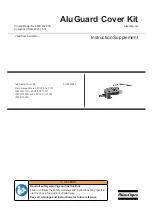
GASGUARD IS CONTROLLER Issue: R2, Date: 26/09/2011, CRN: 7502
Page 18
When setting alarm set-point thresholds, it is important to ensure that they comply with recognised
standards applicable to the application into which the controller is installed. If no standards exist to
specify the alarm thresholds, they should be set based on a full understanding of the application by
a suitably authorised person or body.
•
Alarm levels should be used in the order of their nomenclature, i.e. the first alarm level is A1, the
second is A2 and the third is A3.
•
An alarm that sits higher in the naming order (A1, A2, A3) should be set to a higher trip threshold
than one that sits below it.
Latching Alarms
If an alarm state could be missed because there is likely to be nobody present to observe an event as it occurs, a
latching alarm should be set. A latched alarm will remain active even when the event triggering it is no longer
present. If the Controller undergoes a power cycle following the triggering of a latched alarm, the latched status will
be re-instated once the Controller has re-booted.
Resetting Alarms
A latched alarm may be manually reset by the use of either the ‘LEFT’ key held for 5 seconds (only if the left key
reset feature is enabled in the configuration settings), or by the remote reset terminals. The Controller configuration
allows the left key reset feature to be enabled or disabled. When disabled, only authorised users who know the
Controller system passwords are able to change this to an enabled status. If the left key reset is enabled, a latched
alarm can be reset by any person whether authorised or not. It is up to the user to control access to and/ or
permissions relating to the resetting of latched alarm conditions.
Note: Alarm and relay states are NOT intentionally preserved during the time power is removed from the
controller. Alarm and relay states are re-established once power is restored and the Controller has
completed its self-test. The interpretation of a relay contact state during a power failure, will depend on how
it has been configured to operate.
2.9
Configuring Relay Operation
Each of the four relays within the Controller is a single pole change-over type.
There are three connections associated with each relay, namely ‘Common – C’, ‘Normally Open – NO’ and ‘Normally
Closed – NC’. At any given time, the ‘Common’ terminal will be connected to either the ‘NO’ or ‘NC’ terminal
depending on the relay configuration and the logic of the Zone Block driving it.
Relays can be configured to be ‘Normally Energised – NE’, or ‘Normally de-energised – ND’ (see below).
The context of ‘NC’ and ‘NO’ will change depending on whether a relay coil has been configured to be normally
energised or normally de-energised under non-alarm conditions.
2.9.1
Relay Start-Up Conditions
When the Controller powers up it enters a period of self test for a number of seconds. Following this self-test, there
may be a further start-up delay if this has been configured by the user. During the self test and start-up delay
periods, the relays are held in an ‘alarm’ condition. The state of each relay is set based on the user configuration for
the relay operation. A normally-energised relay (non-alarm state) will sit in the de-energised state during the power
up delay period. A normally de-energised relay (non-alarm state) will sit in the energised state during the power up
delay period. This start-up behaviour is not user-configurable except for the length of the start-up delay.
Once the delay period has expired, the condition of the relays will depend upon how the relay start-up mode has
been defined in the Controller relay configuration. Each relay may independently be set to one of two start-up
modes, namely :- [1] LIVE and [2] LATCHED. In Latched mode, a relay will remain latched in the alarm state after
the start-up delay has expired. To clear this latched condition, a ‘left-key’ reset or a remote reset is required.
For relays set to ‘LIVE’ mode, the relays will assume operation according to the state of the input channel signals and
alarm settings once the start-up delay has expired.
Summary of Contents for gasguard
Page 47: ...GASGUARD IS CONTROLLER Issue R2 Date 26 09 2011 CRN 7502 Page 46 ...
Page 62: ...GASGUARD IS CONTROLLER Issue R2 Date 26 09 2011 CRN 7502 Page 61 B2 Main Menu Flowchart ...
Page 63: ...GASGUARD IS CONTROLLER Issue R2 Date 26 09 2011 CRN 7502 Page 62 B3 Calibration Flowchart ...
Page 64: ...GASGUARD IS CONTROLLER Issue R2 Date 26 09 2011 CRN 7502 Page 63 B4 Configuration Flowchart ...
Page 74: ...GASGUARD IS CONTROLLER Issue R2 Date 26 09 2011 CRN 7502 Page 73 Appendix C Approvals ...
Page 75: ...GASGUARD IS CONTROLLER Issue R2 Date 26 09 2011 CRN 7502 Page 74 ...
Page 76: ...GASGUARD IS CONTROLLER Issue R2 Date 26 09 2011 CRN 7502 Page 75 ...
Page 77: ...GASGUARD IS CONTROLLER Issue R2 Date 26 09 2011 CRN 7502 Page 76 ...
Page 78: ...GASGUARD IS CONTROLLER Issue R2 Date 26 09 2011 CRN 7502 Page 77 ...
Page 79: ...GASGUARD IS CONTROLLER Issue R2 Date 26 09 2011 CRN 7502 Page 78 ...
















































